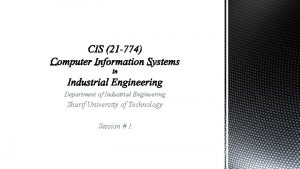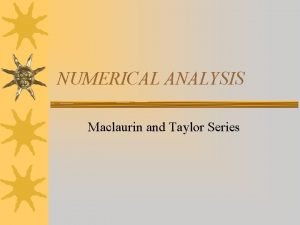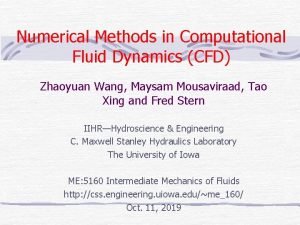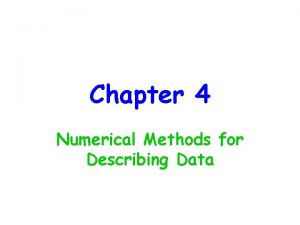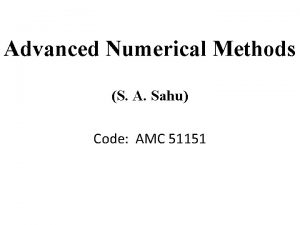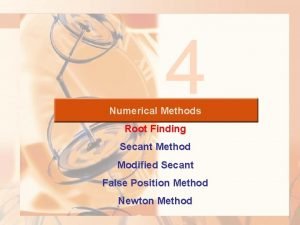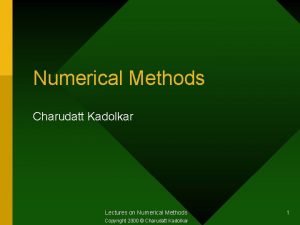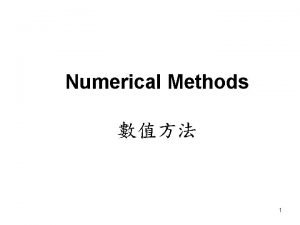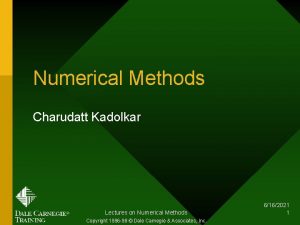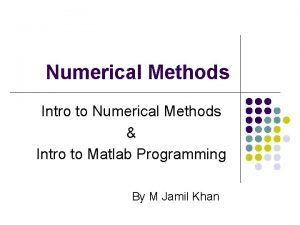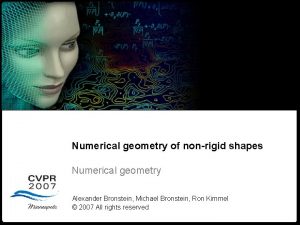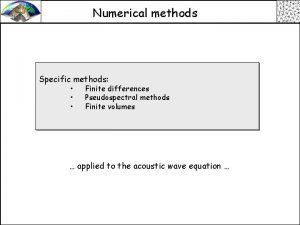Numerical Methods Instructor Laleh Fatahi Shahid Chamran University











- Slides: 11

Numerical Methods Instructor: Laleh Fatahi Shahid Chamran University of Ahvaz Engineering Faculty - Mechanical Engineering Department Chapter 21 Numerical Differentiation 1

Numerical Methods High Accuracy Differentiation Formulas • High-accuracy divided-difference formulas can be generated by including additional terms from the Taylor series expansion. • Inclusion of the 2 nd derivative term has improved the accuracy to O(h 2). • Similar improved versions can be developed for the backward and centered formulas 21 -2

Numerical Methods Forward finite-divided-difference formulas Error O(h) O(h 2) 21 -3

Numerical Methods Backward finite-divided-difference formulas Error O(h) O(h 2) 21 -4

Numerical Methods Centered finite-divided-difference formulas Error O(h 2) O(h 4) 21 -5

Numerical Methods Derivation of the centered formula for f’’(xi) 21 -6

Numerical Methods Example f(x) = -0. 1 x 4 – 0. 15 x 3 – 0. 5 x 2 – 0. 25 x + 1. 2 At x = 0. 5 True value for First Derivative = -0. 9125 Using finite divided differences and a step size of h = 0. 25 we obtain: x f(x) i-2 0 1. 2 i-1 0. 25 1. 1035 Estimate i 0. 50 0. 925 εt (%) i+1 0. 75 0. 6363 i+2 1 0. 2 Forward O(h) Backward O(h) -1. 155 -0. 714 26. 5 21. 7 Forward difference of accuracy O(h 2) is computed as: Backward difference of accuracy O(h 2) is computed as: 21 -7

Numerical Methods Richardson Extrapolation • There are two ways to improve derivative estimates when employing finite divided differences: – Decrease the step size, or – Use a higher-order formula that employs more points. • A third approach, based on Richardson extrapolation, uses two derivative estimates (with O(h 2) error) to compute a third (with O(h 4) error) , more accurate approximation. We can derive this formula following the same steps used in the case of the integrals: Example: using the previous example and Richardson’s formula, estimate the first derivative at x=0. 5 Using Centered Difference approx. (with error O(h 2)) with h=0. 5 and h=0. 25 : Dh=0. 5(x=0. 5) = (0. 2 -1. 2)/1 = -1 [ εt=|(-. 9125+1)/-. 9125| = 9. 6% ] Dh=0. 25(x=0. 5) = (0. 6363 -1. 103)/0. 5=-0. 9343 [ εt=|(-. 9125+0. 9343)/-. 9125| = 2. 4%] The improved estimate is: D = 4/3(-0. 9343) – 1/3(-1) = -0. 9125 [ εt=(-. 9125+. 9125)/-. 9125 = 0% perfect!] 21 -8

Numerical Methods Derivatives of Unequally Spaced Data • Derivation formulas studied so far (especially the ones with O(h 2) error) require multiple points to be spaced evenly. • Data from experiments or field studies are often collected at unequal intervals. • Fit a Lagrange interpolating polynomial, and then calculate the 1 st derivative. As an example, second order Lagrange interpolating polynomial is used below: *Note that any three points, xi-1 xi and xi+1 can be used to calculate the derivative. The points do not need to be spaced equally. 21 -9

Numerical Methods Example The heat flux at the soil-air interface can be computed with Fourier’s Law: q = heat flux k = coefficient of thermal diffusivity in soil (≈3. 5 x 10 -7 m 2/s) ρ = soil density(≈ 1800 kg/m 3) C = soil specific heat(≈ 840 J/kg. Co) Calculate d. T/dz (z=0) first and then and determine the heat flux q. 21 -10

Numerical Methods Solution A temperature gradient can be measured down into the soil as shown below. MEASUREMENTS which can be used to compute the heat flux at z=0: q(z=0) = -3. 5 x 10 -7(1800)(840)(-133. 3 0 C/m)=70. 56 W/m 2 21 -11
 Omid fatahi valilai
Omid fatahi valilai Omid fatahi valilai
Omid fatahi valilai Graphical method numerical analysis
Graphical method numerical analysis Newton gregory forward interpolation formula can be used
Newton gregory forward interpolation formula can be used Taylor series numerical methods
Taylor series numerical methods Types of errors in numerical computation
Types of errors in numerical computation Euler algorithm
Euler algorithm What are numerical method in cfd
What are numerical method in cfd Chronicle of higher education
Chronicle of higher education Descriptive statistics numerical measures
Descriptive statistics numerical measures Newton backward interpolation formula
Newton backward interpolation formula Secant method problems and solutions
Secant method problems and solutions

